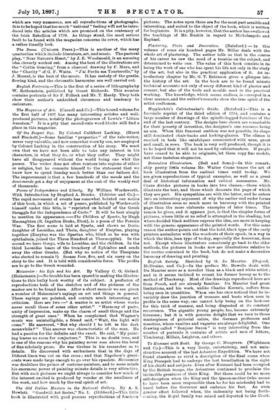Decorative Illustration. (Bell and Sons.)—In this remark. ably pretty little
volume Mr. Walter Crane traces the art of book illustration from the earliest times until to-day. We are given reproductions of typical examples, as well as a great deal of historical information and critical summaries. Mr. Crane divides pictures in books into two classes,—those which illustrate the text, and those which decorate the page of which they are part. His sympathies are with the latter, and he enters into an interesting argument of why the earlier and ruder forma of illustration seem so much more in harmony with the printed page than the more elaborate examples of later times. The reason he gives, and it appears just, is that the simpler forms of pictures, where little or no relief is attempted in the shading, but where decided black outlines express the idea, are more in keeping with the general appearance of the printed words. For this same reason the author points out that the bold, black type of the early printers assimilates with the woodcuts of their epoch, in a way in which the thin, lean type of to-day, especially the American, does not. Except where illustrators consciously go bank to the older methods, the pictures in books now are illustrations relative to the matter contained in the book, but do not make a decorative harmony of drawing and printing.


































 Previous page
Previous page